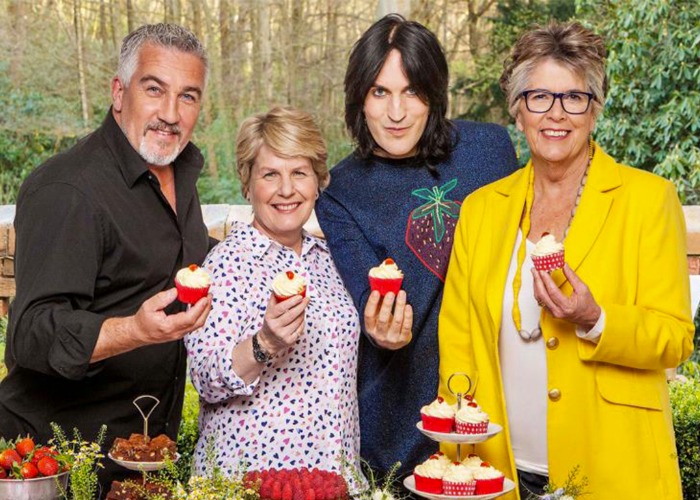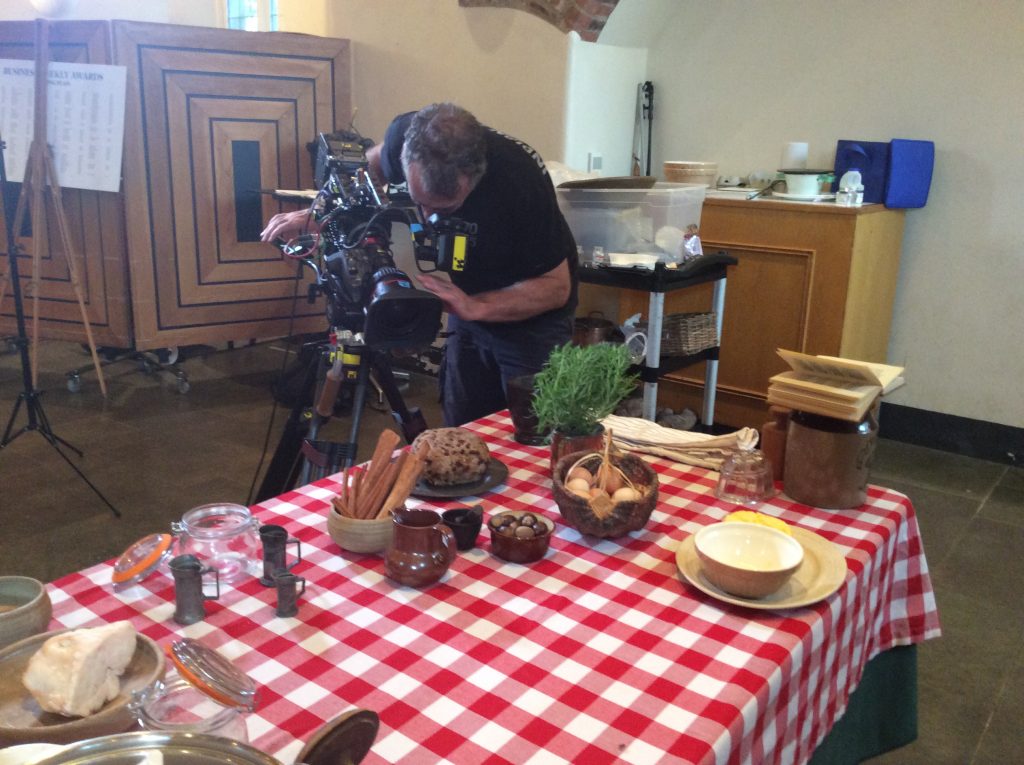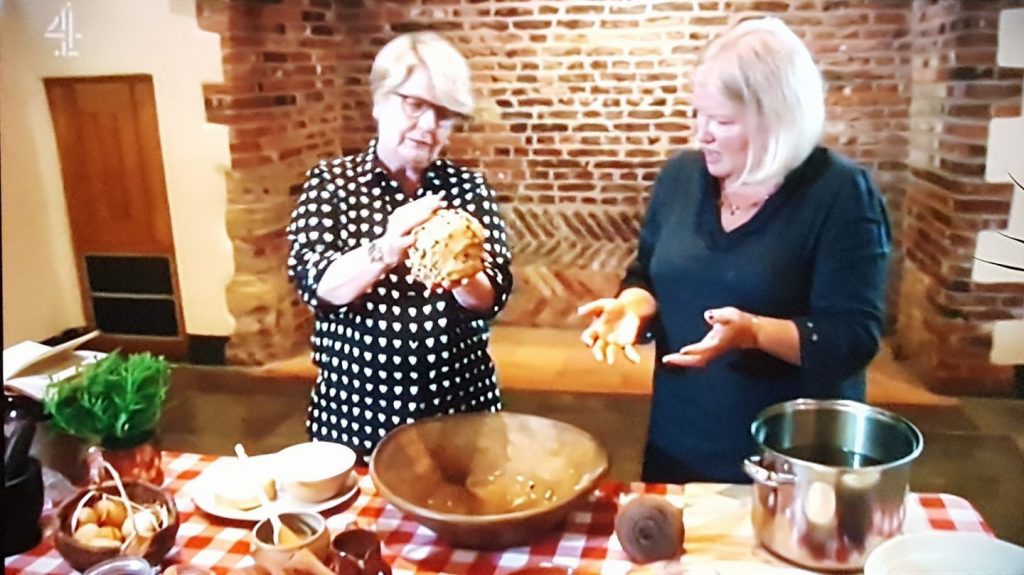Filming on TV as an expert
What is it like to be part of a well-loved food show broadcast on prime time television?
The story started over three months ago.
I had just finished participating in an exam board as an external expert when I received a curious voicemail for a secretive new Channel 4 cookery series. The Museum of Cambridge had recommended me to guest star as a culinary history specialist. I have a background in food science and a deep interest in food history so this was an intriguing request.
Love Production, the company who films the show, gave me more details when I called back. They wanted to film a piece in the ancient kitchens of the Museum of Cambridge. It was to involve cooking and talking about a 17th-century dessert recipe linked with Cambridge.

They needed a culinary historian to guide their presenter through a recipe for this dish on camera. They wanted to film about eight days later. Sometimes it is only two or three days’ notice when I have filmed for other programmes.
When I had confirmed my interest, I had to sign a non-disclosure agreement promising my secrecy until after the broadcast before they would release any more details. This is why, when the contestants participate in the summer for the autumn broadcast, no news ever slips out!
The thrill of finding out it was Great British Bake Off
It delighted me when I found out that I would be filming with the multi-talented presenter Sandi Toksvig. It had just been confirmed that Great British Bake Off was moving from BBC to Channel 4 for the 2017 series with mostly new judges. Sandi Toksvig had long been one of my media heroes as a comedian and presenter. The other presenters and judges were Prue Leith, Paul Hollywood and Noel Fielding.

The success of Great British Bake Off is legendary and has a fascinating history since it started. I could never be one of the 12,000 to apply due to my professional background, so this was much better.
Now to research
I was asked to create a Cambridge Pudding for the show from the original 1615 recipe from “A New Booke of Cookerie” by John Murrell, which was available as a facsimile from the 1638 edition. As I was recreating the pudding itself and the ingredients used as they would be shown on screen I was keen to research this more deeply. Not much was available online, so I turned to my collection of over 500 cookery books. Many of these are about food history and I have some 17th and 18th-century original texts. I used the Cambridge University Library for additional ingredients research, as it was only a stone’s throw from the recipe’s origins.

But what about the Cambridge Pudding?
So what is Cambridge Pudding? It is a sweet, suet and breadcrumb spiced steamed pudding, the first recorded use of a pudding cloth rather than animal skin, specifically animal intestine. So what is Cambridge Pudding? As I explained to Tom Pilgrim when he wrote up my exploits for Cambridge News – “It’s a suet pudding with breadcrumbs to lighten it up”. “It has dried fruit, nutmeg, cinnamon, a small amount of sugar, milk, eggs and flour…. The surprise ingredient was a large pat of butter concealed inside – which kept it moist during steaming.”

In creating the Cambridge Pudding the biggest challenge was working out what certain terms in the recipe meant and getting accurate measurements. Even the first word ‘sierce’ needed some guesswork. It meant sieve the breadcrumbs. It was hard work to create over a kilo of breadcrumbs for the ingredients and the finished dish. I tried using a sieve first which, though laborious, worked well but I eventually succumbed to a food processor.
Hunting down original beef suet also proved interesting. After visiting two butchers I tracked some down to a third well-known butcher near to Cambridge. Suet is the hard fat found around the kidneys. You might recognise it as one of the original ingredients of the traditional Christmas mince pie. The connective tissue needs removing and the fat melted or rendered and strained to clarify it in order to use the suet. I undertook this, using melted suet to complete the pudding, with some un-rendered suet saved to show in the filming.
Shaping the Cambridge Pudding
I made up the pudding shaped into a ball complete with spices, dates and a concealed pat of butter in the middle. This had the effect of moistening the texture whilst it cooked. As the Cambridge Pudding was the first example of using a pudding cloth, I decided that an Oxford pillowcase would be better than muslin and more authentic. It was an exercise in patience to steam and top up with boiling water for the round pudding in a large saucepan for six hours.
Pre-weighing of ingredients for Sandi and me to use was next. Spices were typical of the period and included pepper, unusual for a sweet pudding.
Filming the history segment
Originally, filming was to have been in the museum and we were going to use some of their authentic bowls and dishes. There was more space in the Old Kitchen of Queens College, so the venue changed.
Fortunately, I have my own collection of pewter plates, wooden mixing bowl, antique measures, and choppers. So collecting up these plus boxes, bowls, notes, and all the ingredients I set off into the centre of Cambridge.
The assistant director helped me unload and we went through to the filming location. There the director met us and she introduced me to Sandi Toksvig, the camera operator, the junior assistant and Sandi’s assistant who also did her makeup.
Starting filming
To get some static shots, the table had a check cloth laid on it, ingredients and props I had brought plus bits from the Bake Off collection created the scene.

We only had one chance at making the pudding, so it was important to work from a script. Preplanning by the assistant director achieved this. Sandi and I had a dry run through and then started to make it together as I showed her what to do. We had great fun talking through each of the ingredients, a bit about their history and usage. We got our hands sticky forming the pudding and then adding the large lump of moistening butter into the middle.

We placed the pre-steamed pudding, using the technique of ‘here’s one I made earlier’ on a pewter plate. Sandi then carried it with ceremony into the Great Hall of Queens College. Underneath the portrait of Elizabeth Woodville at the dining hall’s top table Sandi expertly sliced it open and tried some, pronouncing it most excellent.

What gets cut?
Typically, for a few minutes of a programme, half a day of set up and a lot more than 30 minutes’ worth of filming is standard. The editor and producer decide which shots look best in post-production.
So sadly, much recording lands up on the cutting room floor – although now it would be the delete edit box. None of the lovely Great Hall was shown, nor Sandi trying the pudding.
However, it was a wonderful experience and when friends said kind things such as ‘the Queen of Baking’ and ‘a star is born’ I felt very lucky indeed.
So catch up here if you have not had a chance to see Episode 5 of series 1 Season 8 on Channel 4
